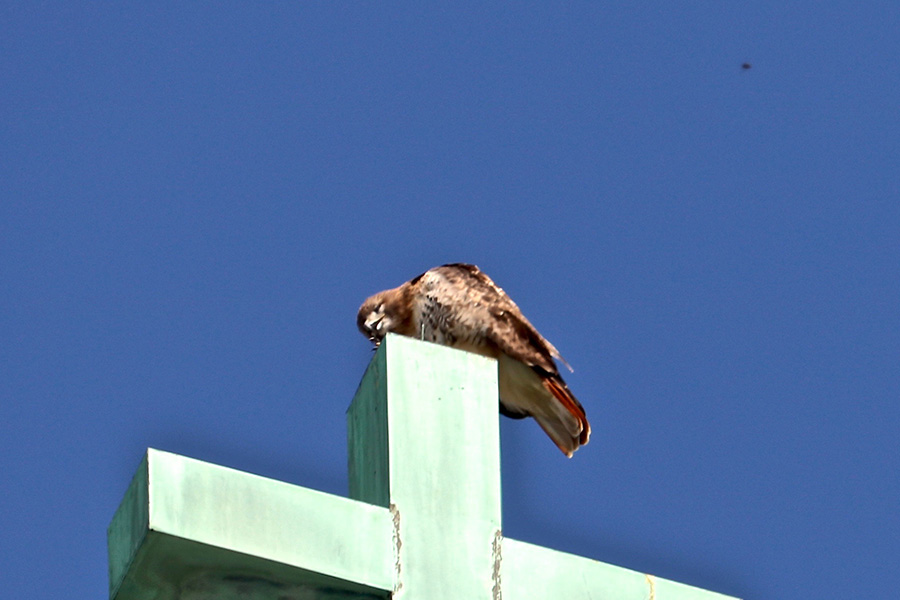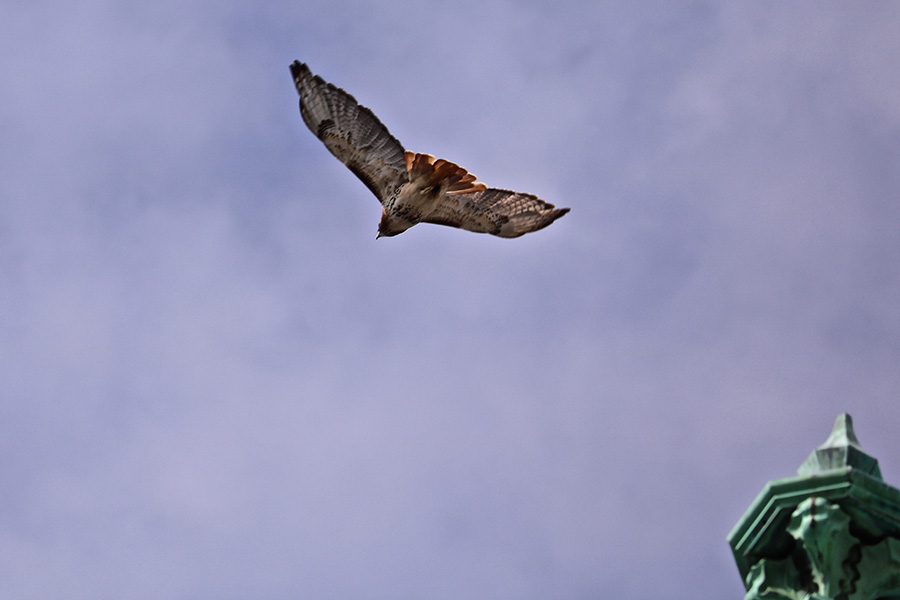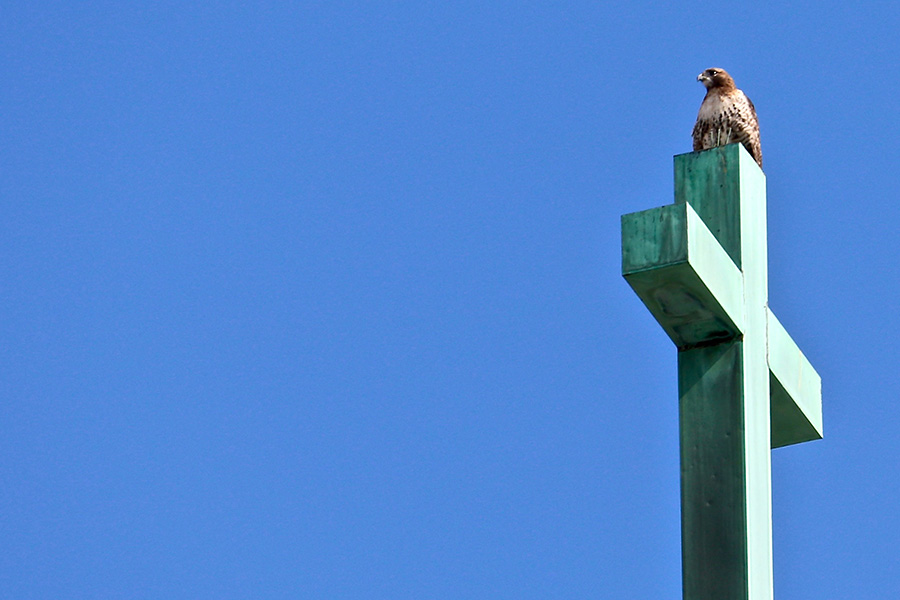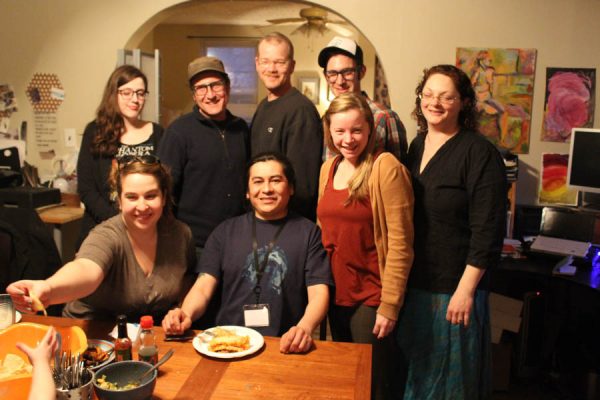URBAN BIRDING: The Famous Fishtown Hawks
Last December, if you remember, was unseasonably warm. Irises and roses were blooming, but the sun was setting at 4:30PM. Everything had taken on a surreal edge, so, I thought perhaps I was dreaming when an unexpectedly regal visitor kept showing-up in my backyard. Surely, animals like this don’t exist in cities, but in magical forest-lands of yore? With her creamy underbelly streaked with dark and her aquiline profile, she belonged in a land of mossy landings and castles, not my backyard full of potted plants and concrete. Who was this bird that would watch me so keenly? What was this majestic beast doing perched on my shed? Hawk? Falcon? I didn’t know, but I was obsessed. I was lonely. My husband was off working in New York and the winter blues had taken hold.
“Something keeps visiting me,” I told everyone I knew. “I think she’s a hawk. I’m being visited by a hawk. I see her. In the trees in front of my house, on my shed, on my neighbor’s railing.” Then she would be gone. My very own white whale — never letting me take her picture. I would worry about her and doubt my own reality when I didn’t see her for a few days, but suddenly, there she was — perched on my shed watching the squirrels, watching my dog.
I’m no expert on birds of prey, but her voice gave her away, she was a red-tailed hawk. You have all heard the scream of a red-tailed hawk. You may not know it, but you have heard it. It’s used in movies and television — any time you hear the scream of an eagle on television — it’s really a red-tailed hawk. It’s the sound used at the beginning of The Colbert Report, it’s the scream heard in a thousand spaghetti westerns. Bald Eagles actually have cute little giggle calls, they sound like a much-less majestic bird. So, when I heard the scream, I knew my visitor was a red-tailed hawk.
That December and January she kept visiting my backyard and keeping an eye on the squirrels. She seemed so calm and stately that I began to think of her as the queen of the neighborhood. I wondered if the tail-less squirrel that I affectionately call Stumpy had been the victim of an encounter with her. “Please, anyone but Stumpy,” I silently pleaded with her.
Then, I didn’t see her for awhile. Where did my queen go? Don’t worry, she didn’t go anywhere. Though, sometimes hawks do migrate south in the winter. Particularly if it is snowy and they can’t see their preferred food-source (rodents) because they are burrowing in the snow. My queen must have found better eats somewhere else in the neighborhood.
It turns out that my queen has a family and that family has a lot of fans. I do not think it is an exaggeration to say that they are the most popular birds in Fishtown. Everyone in Fishtown has a story about the hawks. Men and women gleefully describe their massive wingspan (I’ve noticed, usually, with some healthy exaggeration) and most people have blurry pictures on their phones of the hawks perched on a telephone pole, a tree, or a cross upon St. Laurentius. Then there are the stories that people have of watching them clutch their prey in their massive, strong talons. They kill their prey with these incredibly sharp talons, piercing the rodent or smaller bird to death. You may have even seen evidence of them — an eviscerated pigeon in Palmer Park, a squirrel torn to bits on the sidewalk that surrounds Palmer Cemetery.
It’s funny, because this bird that is so resplendent and other-worldly actually often nests in cities. They are not bothered much by people whom they choose to ignore. Cities, such as our own, offer them plenty to eat in the form of pigeons and rodents. Palmer Park in Fishtown is a popular hunting ground for the hawks. In fact, if you see one of the hawks soaring above Palmer Park look closely, you may see another one nearby. They often hunt in pairs and mate for life. The birds are not only co-parents, but co-hunters and co-builders of their nests. As is often the case in birds of prey, it’s the female of the species that is larger than the male. So when you see the two of them soaring, remember the little one is the male and the larger one is the female.
The hawks have become mascots for the Faithful Laurentians, the organization that opposes the redevelopment of St. Laurentius Church. They even have a Twitter account where the hawks have been given names and ascribed personalities.
The hawks nest in the highest, oldest trees in Palmer Cemetery and they will return to nest there each spring as long as it stays welcoming to them. Unfortunately, our young hawks have had some accidents recently. A couple of them have had run-ins with windows or moving cars and have been brought to various wildlife rehabilitation centers in the area. One, named Noah, is a juvenile — not even a year old. He flew into a window and had extensive injuries this summer. Luckily, a good Samaritan brought him to AARK, a wildlife rehabilitation center in Chalfont, PA. He was cared for and released back into the wild on August 18th.
According to Matthew Danihel, a supervisor at AARK, Noah hung around the wildlife center for about an hour then flew off. Noah will reach sexual maturity at two-years old. He will then find a mate and they will establish a home territory of their own. Courting red-tails put on an amazing display of aerial acrobatics, sometimes locking talons and plummeting towards the earth. They survey their territories by soaring. When you see them perched they are scanning the area for prey. They can spot a tiny mouse from 100 feet away. In the spring, like all red-tails, Noah’s future mate will lay a clutch of 1-5 eggs in a nest that they build together out of sticks in a tall tree or if he chooses to become an urban hawk, perhaps on a building’s ledge. The female will incubate the eggs while he brings her food. When the babies hatch they will be completely helpless and dad will continue to bring his mate food which she will feed to the hatchlings. Our Fishtown hawks will continue to lay clutch after clutch each spring in Palmer Cemetery. I hope this continues for many years to come — their average lifespan in the wild is 21-years!
This is where I beg you not to use rat poison. If you love our hawks, please, use snap traps; a mouse in it’s death throes makes an easy snack for our beloved hawks. Unfortunately, the blood-thinner used in rat poison kills hawks, too, causing them to bleed-out and die a painful death. A dead mouse may be icky to pick up, but you are doing our feathered-raptor-friends a kindness.
For information on donating to AARK check out their website: http://www.aark.org
A release video of Noah will also be appearing on their Facebook page: https://www.facebook.com/AarkWildlife/?ref=aymt_homepage_panel •









